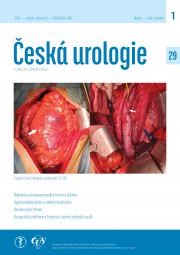Ces Urol 2014, 18(1):21-25 | DOI: 10.48095/cccu2014003
Benefit of determining [-2]proPSA levels in the differential diagnosis of prostate cancer
- 1 Laboratoř imunodiagnostiky a Centrální izotopová laboratoř LF, Plzeň
- 2 Urologická klinika FN a LF UK, Plzeň
- 3 Soukromá urologická praxe, Plzeň
Aim:
The goal of this study was to examine if determining [-2]proPSA levels and calculating the Prostate Health Index (PHI) could improve overall sensitivity and specificity of this marker in the diagnosis of prostate cancer compared to standard markers (PSA and %freePSA), and propose an optimal PHI cut-off.
Methods:
A group of 76 patients with suspected prostate cancer, who were scheduled to undergo prostate biopsies, was tested to determine the total PSA, freePSA and [-2]proPSA levels, calculated %freePSA and Prostate Health Index (PHI). Biomarkers were determined using chemiluminescent technology on a Dxl 800 (Beckman Coulter, USA). Statistical analysis was performed using SAS version 9.2.
Results:
We found a statistically significant improvement in the area under the ROC (AUC) for both [-2]proPSA (0.77) and especially for PHI (0.88) levels compared with total PSA (0.59) and % freePSA (0.61) levels. None of the patients included in this study, with histological diagnosis of prostate cancer on biopsy, had a PHI level under 40.
Conclusion:
Determining the [-2]proPSA and derived PHI values contributes significantly to accuracy in the process of the differential diagnosis between BPH and prostate cancer. Based on out experience, a PHI cut-off of 40, with a gray area between 30 and 40, is optimal for use in routine clinical practice.
Keywords: benign prostatic hyperplasia, prostate cancer, marker, PHI, [-2]proPSA
Received: November 20, 2013; Accepted: January 20, 2014; Published: January 1, 2014
References
- Heijnsdijk EA, der Kinderen A, Wever EM, et al. Overdetection, overtreatment and costs in prostate-specific antigen screening for prostate cancer. Br J Cancer.2009; 101(11): 1833-1838.
 Go to original source...
Go to original source...  Go to PubMed...
Go to PubMed... - Hanuš M, Matoušková M, Dušek L. Prostate carcinoma. current dilemma of urooncology. how to help the needed and not to harm the others. Klinicka Onkologie 2013; 26(3): 170-178.
 Go to original source...
Go to original source...  Go to PubMed...
Go to PubMed... - Ferda J, Hora M, Hes O, et al. Prostate imaging with 3T MRI in patiens with elevated PSA levels. Ces Radiol 2012; 66(1): 9-17.
- Ferda J, Kastner J, Ferdova E, et al. Moelcular imaging of the prostatic carcinoma - our experience. Ces Radiol 2012; 66(3): 289-295.
- Ferda J, Kastner J, Hora M, et al. A role of multifactorial evaluation of prostatic 3T MRI in patients with elevated prostatic-specific antigen levels: Prospective comparison with ultrasound-guided transrectal biopsy. Anticancer Res 2013; 33(6): 2791-2795.
- Roehl KA, Antenor JA, Catalona WJ. Serial biopsy results in prostate cancer screening study. J Urol 2002; 167(6): 2435-2439.
 Go to original source...
Go to original source...  Go to PubMed...
Go to PubMed... - Serefoglu EC, Altinova S, Ugras NS, et al. How reliable is 12-core prostate biopsy procedure in the detection of prostate cancer? Journal of the Canadian Urological Association 2013; 7(5-6): E293-E298.
 Go to original source...
Go to original source... - Dema A, Taban S, Lazar E, et al. Pseudobenign prostate carcinomas: Causes of false-negative biopsy results. Rom J Morphol Embryol 2011; 52(3 Suppl): 963-974.
- Houlgatte A, Vincendeau S, Desfemmes F, et al. Use of [-2] pro PSA and phi index for early detection of prostate cancer: A prospective of 452 patients. Prog Urol 2012; 22(5): 279-283.
 Go to original source...
Go to original source...  Go to PubMed...
Go to PubMed... - Lazzeri M, Haese A, de la Taille A, et al. Serum isoform [-2]proPSA derivatives significantly improve prediction of prostate cancer at initial biopsy in a total PSA range of 2-10 ng/ml: A multicentric european study. Eur Urol 2013; 63: 986-994.
 Go to original source...
Go to original source...  Go to PubMed...
Go to PubMed...


